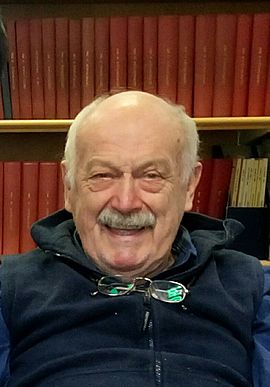Andrew N. Schofield facts for kids
Quick facts for kids
Andrew N. Schofield
FRS FREng
|
|
|---|---|

Schofield in 2016
|
|
| Born | 1 November 1930 Cambridge, England
|
| Died | 27 January 2025 (aged 94) |
| Nationality | English |
| Alma mater | Cambridge University, UK |
| Known for | Critical state soil mechanics, Cam Clay, Geotechnical centrifuge modelling |
| Spouse(s) | Margaret Green (m.1961) |
| Awards | US Army Distinguished Civilian Service Award, 1979 20th Rankine Lecture, 1980 Fellow of the Royal Academy of Engineering, 1986 Fellow of the Royal Society, 1992 James Alfred Ewing Gold Medal from the Institution of Civil Engineers, 1993 |
| Scientific career | |
| Fields | Soil Mechanics, Geotechnical Engineering |
| Institutions | Cambridge University, UK University of Manchester Institute of Science and Technology (UMIST) |
| Thesis | The development of lateral force during the displacement of sand by the vertical face of a rotating model foundation (1960) |
| Doctoral advisor | Kenneth H. Roscoe |
| Notable students | Malcolm D. Bolton, Robert Mair, Sarah Springman |
Andrew Noel Schofield (born November 1, 1930 – died January 27, 2025) was a British engineer. He was an expert in soil mechanics and geotechnical engineering. He was also a professor at the University of Cambridge.
Contents
Early Life and Education
Andrew Schofield was born in Cambridge, England, on November 1, 1930. His parents were Rev John Noel Schofield and Winifred Jane Mary Eyles. In 1961, he married Margaret Eileen Green.
He studied engineering at Christ's College, Cambridge and finished his degree in 1951. After college, he worked in Africa, in a place called Nyasaland Protectorate (which is now Malawi). There, he studied different types of soil and how to build roads cheaply.
Developing New Ideas in Engineering
Andrew Schofield returned to Cambridge University to work on his PhD with Professor Kenneth H. Roscoe. He finished his PhD in 1961. He became a lecturer and later a Fellow at Churchill College, Cambridge in 1964.
Understanding Soil Behavior
In 1958, Schofield, along with Ken Roscoe and Peter Wroth, published an important paper. This paper showed how to use ideas from plasticity theory and critical state soil mechanics to understand how soils behave when pushed or squeezed. This work led to a special model called 'Cam Clay'. It helps engineers predict how soil will act under different conditions.
Using Centrifuges for Soil Tests
Schofield was very interested in using large spinning machines called geotechnical centrifuges. These machines can create forces similar to gravity, allowing engineers to test small models of buildings or dams as if they were full-sized. He was inspired by work done in the USSR.
He built a first version of a geotechnical centrifuge in Cambridge. Later, in 1966, he used a larger centrifuge at the English Electric Company in Luton, UK, for his soil studies.
Leading the Soil Mechanics Group
In 1968, Schofield became a professor at the Institute of Science and Technology in Manchester (UMIST). There, he developed an even bigger geotechnical centrifuge. After Professor Roscoe passed away in 1970, Schofield returned to Cambridge in 1974. He became a professor in the Cambridge University Engineering Department and led the team studying soil mechanics.
Working with engineer Phillip Turner, he helped create a very large 5-meter radius geotechnical centrifuge at Cambridge University. This machine is still used a lot today.
Awards and Retirement
Andrew Schofield was recognized for his important work. He became a Fellow of the Royal Academy of Engineering in 1986. In 1992, he was also made a Fellow of the Royal Society, which is a very high honor for scientists.
He retired from Cambridge University in 1997. Even after retiring, he continued to work and published a book in 2005. Andrew Schofield passed away on January 27, 2025, at the age of 94.
Schofield's View on Soil Strength
Professor Schofield had a different idea about what makes soil strong. He believed that the strength of soil comes mainly from how its tiny particles rub against each other (friction) and how they lock together (interlocking).
He thought that a popular idea, called the Mohr Coulomb equation, was not completely right. This equation, used a lot since the 1930s, said that soil's strength comes from "cohesion" (particles sticking together) and friction. Schofield argued that for many types of soil, especially those that have been moved around, cohesion is not the main reason for their strength. He emphasized friction and interlocking instead.

